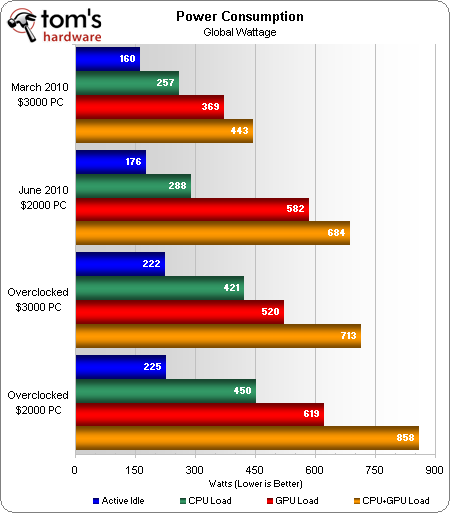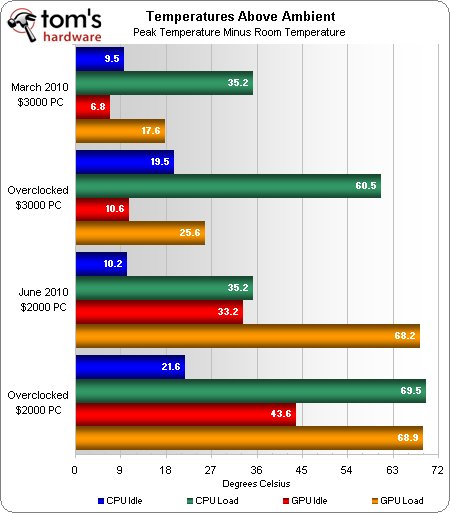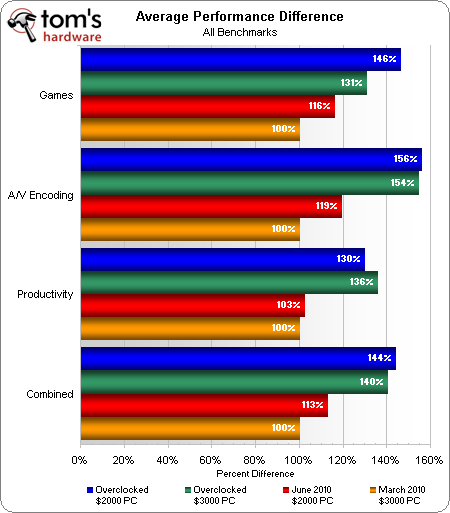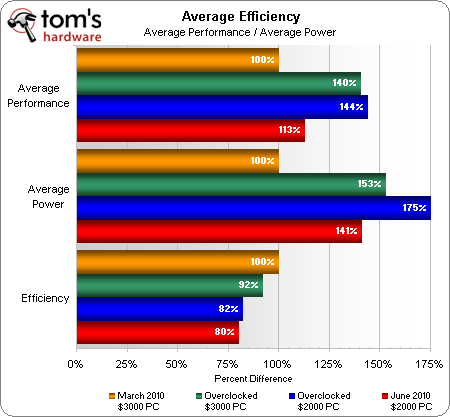System Builder Marathon, June 2010: $2,000 Performance PC
Power, Heat, And Efficiency
We loaded up each system first with eight threads of Prime95, then with the FurMark stress test, and finally with FurMark and seven Prime95 threads simultaneously. We then waited around 30-45 minutes for the power consumption to settle to a consistent level before taking our global wattage readings from the AC power source.
Our $2,000 build uses far more power than its predecessor, even at stock settings. Overclocked power consumption caused even greater concern, as it appears to exceed the power supply's rated capacity. A quick check of the DA750 specification sheet put us at some ease however, since a shift from 50% to 100% load causes the power supply's efficiency to drop from 80% to 77%. That means it was only outputting between 660 and 680W at the above reading, and our remaining discomfort is caused by the idea that we're wasting nearly 200W of power in the conversion process.
This month’s full-load GPU temperature remained relatively constant, regardless of ambient conditions or overclock levels, simply because we left its automatic fan control enabled. Not seen above is the CPU temperature reached with the $3,000 PC during the combined load test, which is an important exclusion, since the CPU and GPU of that system were tied into the same liquid-cooling system. Looking back at our test notes, the CPU temperature under combined load was approximately the same for both systems, while the $3,000 machine’s reduced cooling performance was due mostly to a flow reduction at the GPU water block.
We also tried the powerful 38 mm and 3,900 RPM CPU fan photographed and discussed in our previous pages and found that CPU temperatures dropped by five degrees Celsius, while noise more than doubled. That five-degree reduction didn’t even allow the smallest increase in CPU clock speed. It’s a fine fan when speeds are reduced, but probably not worth the effort for most builders.
What our $2,000 machine lost in CPU overclocking it more than made up for in graphics prowess. A combined performance number relative to our comparison machine can now be used to calculate efficiency.
High-power consumption turns the new system’s performance victory into an efficiency defeat. We could almost take solace in the increased efficiency that overclocking brought the $2,000 machine, if not for the fact that even its most efficient settings are a full 10% lower than our previous build’s least-efficient settings.
Get Tom's Hardware's best news and in-depth reviews, straight to your inbox.
Current page: Power, Heat, And Efficiency
Prev Page Benchmark Results: Synthetics Next Page Conclusion-
gkay09 ^ Very good selection of parts IMO...Reply
It still has a room for a SSD -> OCZ Vertex 2/ Agility 2 50GB or Vertex/ Agility 60GB...these both retail under $200... -
Aatish That's just sad! in 3 months your 2000$-3000$ investments depreciated at awful rate! and usually when an average customer builds a PC he at-least don't expect to repeat the process with-in few months.Reply
But, a good rig!for someone who is just about to build his new PC with that much budget! -
frye Maybe you guys should give away a $10,000 PC in September ;)Reply
Oh, and are those temps right? Nearly 93 C CPU temp when overclocked? I'd scale that back a bit... -
TomD_1 I wanted to enter the competition... but I live on the other side of the world :(Reply
Great build though, might have put a bit more money towards the case if I was building it -
Flamango I love SBMs, and the fact that I haven't built my p55 setup yet, and I'm sure the Megahalems will look great in my new case. Can't wait for the cheaper builds!Reply -
Relayer Need a bigger PSU. Why are you using the one you did? You have the funds to buy one that will drive this system properly.Reply -
a4mula Can't say I agree with much here. You pick up a budget case that's going to restrict airflow due to lack of wire management, and then drop 75 on a cooler. Megahalems are spectacular, I own one myself but you've defeated any gain by placing it in a subpar enclosure. Should have just went with a 902 and a CM 212+. Would have been cheaper and less restrictive.Reply
I still fail to see the love of 1366 in these builds where there is no intention of upgrading to hexacore. Save the $100 and do a p55 i7-860 build. You're going to get performance that rivals the 930 on every benchmark including those that take x8/x8 into consideration. You'll surpass the 930 in a few.
700 for dual 470s when you can get dual 5850s for 560.
PSU that is being heavily overtaxed. You're risking the entire 2k machine by running 100w over the psus rated value. The only thing keeping this machine running is the fact that Silverstone makes high quality parts and you have a single rail. Had this of been a multi-rail you would have been pulling out a gpu, scaling back your overclocks, or buying a new psu. At some point you have to wonder if this is a safety hazard.
Sorry Thomas, just not feeling this build at all. I see about $400 of budget that could have easily have been trimmed and would have been within a few percentage points of the current build. This could have gone towards anything from your much wanted redundant storage to SSD drives. -
madass $50 cases with side opened>hiogh end case with side closed.Reply
And no, I've never had problems with dust. And I own a dog. Go figure. -
madass IMO they should have taken an i5 750 (USD80 saved) and 4GB of CL7 1066-no game out there uses more than 2GB, more than 4GB is a waste(at least another USD40 saved). P55 mobo with 2x x8= USD 120. 80 saved. Total: USD200. Dual 5870's anyone? Don't forget- the 5970 has a lot of problems with CFire scaling- even a pair of 5850's can beat it in most cases, especially at 2560-blame crappy ATI drivers.......Reply -
Crashman RelayerNeed a bigger PSU. Why are you using the one you did? You have the funds to buy one that will drive this system properly.Nobody thought it would draw more than 750W peak load. Even so, the article has been revised to show that the actual power output was only 660W to 680W, well below the unit's limits.Reply
a4mulaCan't say I agree with much here. You pick up a budget case that's going to restrict airflow due to lack of wire management, and then drop 75 on a cooler. Megahalems are spectacular, I own one myself but you've defeated any gain by placing it in a subpar enclosure. Should have just went with a 902 and a CM 212+. Would have been cheaper and less restrictive.I still fail to see the love of 1366 in these builds where there is no intention of upgrading to hexacore. Save the $100 and do a p55 i7-860 build. You're going to get performance that rivals the 930 on every benchmark including those that take x8/x8 into consideration. You'll surpass the 930 in a few.I'm not seeing the point of the Blueray drive. If this was a bare bones value to performance build it sticks out like a sore thumb. 700 for dual 470s when you can get dual 5850s for 560. Sorry Thomas, just not feeling this build at all. I see about $400 of budget that could have easily have been trimmed and would have been within a few percentage points of the current build. This could have gone towards anything from your much wanted redundant storage to SSD drives.It's OK a4mula, but you're completely wrong.
1.) The air temperature in the case was excellent. Tom's has tested enough cases to know that smaller models that fit tightly around the CPU cooler do an excellent job of cooling the CPU area, so long as the rear fan is fast enough.
2.) Tom's tested the 212+, and it's only fair (not great). This months build was expected to reach high overclocks.
3.) Tom's has also done an i7-860 build around six months ago, that CPU was one of the worst-overclocking i7's Tom's has ever used. Subtract around 4-8% in game performance for using x8 slots, and the value evaporates.
4.) Would you build a $1000 machine that can't run DVD's? Then why would you build a $2000 machine that can't play BRD's? BRD's are close enough to mainstream that not having the capability should be the thing that "sticks out" IMO, but you do make a decent argument since this pick was based on an opinion.
5.) Yeh, you saw how dual 470's smashed the performance of dual 5870's? Oh, that was a 5970...well there you go. 470's take the big win.
So a4mula, points 1-3 and 5 are purely factual and based on testing. You might be able to win the opinion-based argument on #4, but whoever gave you the thumbs-up was also wrong so don't let popularity mislead you.





